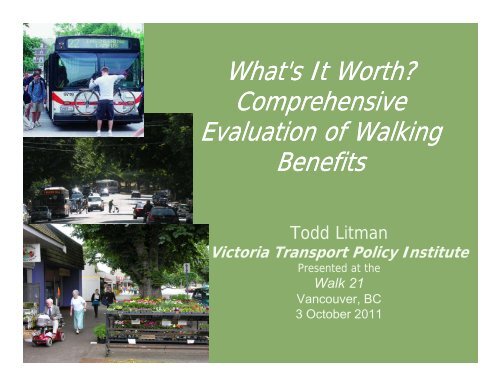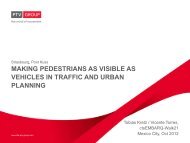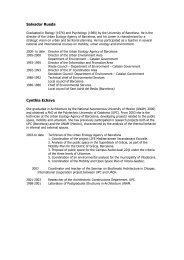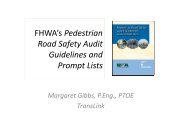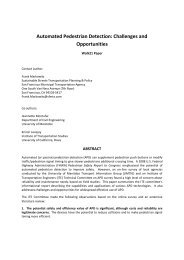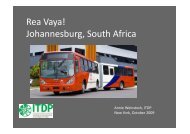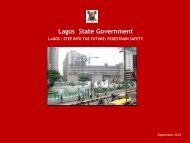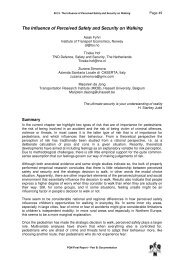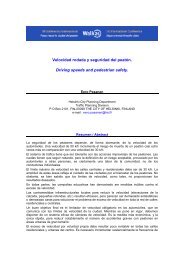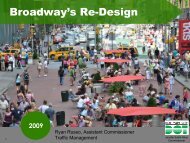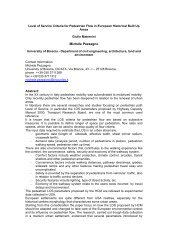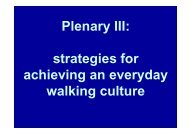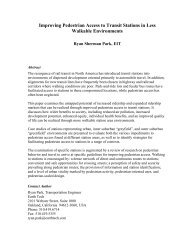Comprehensive Evaluation of Walking Benefits PDF - Walk21
Comprehensive Evaluation of Walking Benefits PDF - Walk21
Comprehensive Evaluation of Walking Benefits PDF - Walk21
Create successful ePaper yourself
Turn your PDF publications into a flip-book with our unique Google optimized e-Paper software.
What's ItWorth?<strong>Comprehensive</strong><strong>Evaluation</strong> <strong>of</strong> <strong>Walking</strong><strong>Benefits</strong>Todd LitmanVictoria Transport Policy InstitutePresented at theWalk 21Vancouver, BC3 October 2011
Sustainable PlanningSustainabilityemphasizes theintegrated nature <strong>of</strong>human activities andtherefore the need tocoordinate planningamong different sectors,jurisdictions andgroups.9/2/2011
Value <strong>of</strong> Highway ExpansionWhen the highwaysystem was being38%33%developed in the28%1950s and 60s it23%provided high returns 18%13%on investment. Now8%that the system is3%mature, economic-2%returns havedeclined.nomic Retu urnsAnnual EcoHighway CapitalPrivate Capital1950-59 1960-69 1970-79 1980-89
Paradigm Shifts• Growth - expanding,doing more.• Developmentelopment-improving, doingbetter.• Mobility - physicalmovement.• Accessibility -obtaining desiredgoods, services andactivities.
Trends Supporting Multi-ModalismModalismPer Ca apita Annua al Vehicle Mi ileage12,00010,0008,0006,0004,0002,0000USUK1940 1950 1960 1970 1980 1990 2000 2003Year• Motor vehicle saturation.• Aging population.• Rising fuel prices.• Increased urbanization.• Increased traffic andparking congestion.• Rising roadwayconstruction costs anddeclining economicreturn from increasedroadway capacity.• Environmental concerns.• Health Concerns
Optimal Modal SplitMod de Split100% Small shifts fromautomobile to alternativemodes can result in a80%60%40%20%0%Automobile-DependentWalk-Bike-TransitAutomobileMulti-Modallarge increase in walking,cycling and public transitdemand.For example, a 5-pointshift can increase use <strong>of</strong>alternative modes by50%.9
Total Travel TrendsDuring the lastcenturyautomobile travelgrew significantly Bicyclingwhile travel byalternative modesstayed stagnant.During the nextcenturyautomobile travelgrowth willdecline while use<strong>of</strong> other modeswill increase.1940 1960 1980 2000 2020 2040 2060<strong>Walking</strong> andPublic TransitAutomobile
Benefit CategoriesCategory Examples Factors Affecting Their MagnitudeImproved walking andcycling conditions.Increased walkingand cycling activityReduced automobiletravelLand use impacts.Direct benefits to existing and new usersfrom having convenient and safe walkingand cycling conditions, plus option valueand equity benefitsUser enjoyment and health benefitsCongestion reduction, road and parkingfacility cost savings, consumer savings,accident reductions, energy conservationand emission reductionsMore compact and accessible land usedevelopment (“smart growth”). Supportfor planning objectives such as urbanredevelopment and habitat preservation.Degree <strong>of</strong> improvement. Number and type <strong>of</strong>potential users. Whether it improves basicmobility for disadvantaged people.Amount walking and cycling increases. Numberand type <strong>of</strong> users. Whether it helps currentlysedentary people achieve physical activitytargets.Amount and type <strong>of</strong> automobile travel reduced(reductions in urban-peak travel tend toprovide large benefits).Degree that a policy or project supports landuse planning objectives.
<strong>Walking</strong> & Cycling Benefit CategoriesImproved Active Increased Active Walkable Community Reduced AutomobileTransport Conditions Transport Activity Design Travel• Improved userconvenience andcomfort• Improved traveloptions, particularlyfor non-drivers• Improved localproperty values• Improved publicfitness and health• User enjoyment• Increased communitycohesion (positiveinteractions amongneighbors)• More livablecommunities.• Reduced d sprawl(more compact,mixed development)reduces landconsumption, reducescosts <strong>of</strong> providingpublic services,preserves openspace.• Improvedaccessibility,particularly for nondrivers• Reduced vehicleownership• Reduced trafficcongestion• Road and parking costsavings• Consumer cost savings• Reduced d crash risk toothers• Air and noise pollutionreductions• Energy conservation• Economic developmentbenefits
Comparing <strong>Benefits</strong>PlanningExpand Efficient and Alt. Shifts from AutoObjectives Roadways Fuel Vehicles Alternative ModesVehicle Travel Impacts Increased VMT Increased VMT Reduced VMTReduce traffic congestion Roadway cost savingsParking cost savingsConsumer cost savingsImprove mobility optionsImprove traffic safetyEnergy conservation Pollution reduction Land use objectivesPublic fitness & health
Conventional <strong>Evaluation</strong>Generally Considered• Congestion impacts• Vehicle operating costs• Per-mile crash impacts• Per-mile pollutionemissions.Often Overlooked• Parking costs• Total consumer costs• Downstream congestion• Crash, energy & pollutionimpacts <strong>of</strong> changes in mileage• Land use impacts• Impacts on mobility options fornon-drivers/equity impacts• Changes in active transportand related health impacts14
Comparing Costs$0.30icle MileDollarsPer Veh$0.25$0.20$0.15$0.10$0.05Often OverlookedGenerally Considered$0.0015
DiversityTransportation Costs$0.30$0.25$0.20$0.15$0.10$0.05$0.00AutomobileBicyclingWaterBarrie rier EffectTraffic cServicesNoiseTransport Dhouse GasGreenhoOwnershipCrash DamagesVehicle OperationParkingRoad dFacilitiesLand UseImpactsCon ongestionResourcesAir PollutionLanand Valueollars Per Passenger-MileVehicle OwDo
International Mode Share(Bassett, et al. 2008) 17
Counting All <strong>Walking</strong>NMTTransitAutoMore comprehensivetravel surveys typicallyincrease the portion <strong>of</strong>nonmotorized travel2-6 times by countingcurrently overlookedwalking and cyclingtrips.Conventional<strong>Comprehensive</strong>
Mode Share (2009 NHTS Data)20%15%10%TransitBikeWalkAlternative modesrepresent a largerportion <strong>of</strong> trips andtravel time than traveldistance.5%0%Total Trips Total Travel Time Total TravelDistance
User <strong>Benefits</strong>Improved walkability provides:• User benefits Increased convenience,comfort, safety, accessibility andenjoyment• Option value <strong>Benefits</strong> <strong>of</strong> havingmobility options available in case theyare ever needed.• Equity benefits Helps economically,socially or physically disadvantagedpeople.• Avoided chauffeuring Time and• Avoided chauffeuring Time andfinancial savings to motorists.
Transportation Affordabilitynsprot Por rtion <strong>of</strong> Ho ouseholdExp enditures25%20%15%10%5%Automobile DependentMuti-ModalTra0%0 200 400 600 800 1,000 1,200Per-Capita Annual Transit Passenger-Miles
Vehicle Cost SavingsCategory Description How It Can Be Typical ValuesMeasuredVehicleFuel, oil and tire wear. Per-mile costs times mileage 10-15¢ per vehicle-mile. HigherOperating Costs reduced. in congested conditionsMileage-RelateddepreciationMileage-related depreciation,repair costs and lease fees.Per-mile costs times mileagereduced.5-15¢ per vehicle-mile,depending on vehicle type.Special cost Tolls, parking fees, etc. Specific market conditions. Varies.Reduced vehicle ownershipVehicleOwnershipReductions in fixed vehiclecosts.times vehicle ownership costs.$2,000 to $3,000 per vehicleyear.ResidentialReduced d residential parkingReduced d vehicle ownership$100-1,200 1 per vehicle-year.Parking coststimes costs per space.
Parking Cost SavingsMost people have no idea<strong>of</strong> the real costs <strong>of</strong>providing parkingfacilities.Most vehicles are worthless than the total value<strong>of</strong> parking spaces theyuse. The majority <strong>of</strong> thesecosts are subsidized (notborne directly by users)Annu ualized Cost Per Space$4,000$3,500$3,000$2,500$2,000$1,500$1,000$500$0Operating & Maintenance CostsConstruction CostsLand Cost
Congestion Reduction• Some trips shift from driving to non-motorized modes.• Non-motorized improvements supportshifts to public transit.• Walkable communities are morecompact. This may increase congestionintensity (measured as roadway level-<strong>of</strong>service)but reduces travel distances andtherefore per-capita congestion costs.• Reduces barrier effects (delays topedestrians and cyclists caused by widerroads and increased vehicle traffic).
Safety <strong>Benefits</strong> (U.S. Cities)
Safety <strong>Benefits</strong>Traffic Fa atalities Per100,000Population25 Northern EuropeSouthern EuropeUS20CanadaAffluent Asian CitiesAustralia1510500% 10% 20% 30% 40% 50%Percent <strong>of</strong> All Trips by Non-Motorized Modes
Smart Growth Safety ImpactsAnnual Tr raffic DeathsPer 100,000 0 Population4035302520151050Most SprawledSmartest Growth
What Gets People Moving?• Recommended minimum: 20minutes <strong>of</strong> moderate exercisea day.• Although there are manyways to be physically y active,active transportation is one <strong>of</strong>the most common, andimproving activetransportation conditions is apractical way to increasephysical activity.
Valuing Health <strong>Benefits</strong>• New Zealand valuation:– Cycling = $1.92 per additional mile– <strong>Walking</strong> = $3.70 per additional mile• Gotschi (2011) estimated that Portland, Oregon’s 40-year $138-605 million bicycle facility investments provide$388-594 million healthcare savings, $143-218 millionfuel savings, and $7-12 billion in longevity value.• Guo and Gandavarapu (2010) conclude that theincremental costs <strong>of</strong> residential sidewalk construction isusually repaid by the health benefits <strong>of</strong> increasedphysical fitness and reduced vehicle air pollution.
Land Use Impacts On TravelAverage Daily Min nutes80Automobile706050403020100TransitWalkAuto Mixed Multi-ModalDependentUrban Index Rating30
Community Economic Impacts• Project employment impacts.Jobs Creat ted Per $1 m illion Expenditure2520151050PetroleumGeneralAutomobileExpensesGeneralConsumerExpendituresPublic Transit• Business savings and efficiencies(congestion, parking, taxes)increases productivity andcompetitiveness.• Reducing vehicle expenditures andexpanding transit service increasesregional employment and businessactivity.• Agglomeration efficiencies.• Supports strategic land usedevelopment objectives.• Increases affordability, allowingbusinesses to attract employees inareas with high living costs.• Changes in household expenditures• Changes in household expenditureson vehicles and fuel.
Property Value Impacts• 5.2% higher residential property values and 4.9% higher retailrents in London neighborhoods h with good walking conditions(Buchanan 2007) .• 15.5% higher house prices in walkable neighborhoods (Songand Knaap 2003) .• 11% higher property values in New Urbanist neighborhoods(Eppli and Tu 2000).• A one-point Walkscore is associated with a $700 and $3,000increase in home values (Cortright 2009).• 1% to 9% increase in <strong>of</strong>fice, retail and apartment values foreach 10-point WalkScore increase (Pivo and Fisher 2010).• Residential property values tend to increase with proximity topublic trails (Racca and Dhanju 2006).• Each foot closer to Ohio’s Little Miami Scenic Trail increasessingle-family property sale prices $7.05, a 4% increase iflocated 1,000 feet closer to the trail (Karadeniz 2008).
Per Capita GDP and VMTProductivity tends todecline with increasedmobility. (Each dot is aU.S. urban region.)Bureau <strong>of</strong> Economic Analysisand FHWA dataPer Capita Annual GD DP (2004)$60,000$50,000$40,000000$30,000$20,000$10,000$0R 2 = 02923 0.29230 5,000 10,000 15,000 20,000Per Capita Annual Mileage (2005)
Smart Growth Development• Compact (density)• Mixed development (proximity)• Urban villages• Connectivity• Walkability/bikability• Public transport• Public realm• Parking management34
Smart Growth <strong>Benefits</strong>EconomicSocialEnvironmental• Increased resourceefficiency• Lower developmentcosts• Lower public servicecosts• Road and parking costsavings• Economies <strong>of</strong>agglomeration• More efficienttransportation• Improved transportoptions, particularlyfor nondrivers• Improved housingoptions• Community cohesion• Preserves uniquecultural resources• More opportunitiesto exercise• Greenspace & habitatpreservation• Reduced air pollution• Increased energyefficiency• Reduced waterpollution• Reduced “heat island”effect
Social EquityEquity objectives:• An equal share <strong>of</strong> public resourcesfor people with equal needs.• Savings and benefits to lower-income people.• Increased opportunity to peoplewho are physically, socially oreconomically disadvantaged.• Basic mobility.
Basic MobilityCertain goods and services areconsidered “essential” or “basic”:• Emergency services (police, fire,ambulances, etc.).• Public services and utilities (garbagecollection, utility maintenance, etc.).• Health care.• Basic food and clothing.• Education and employment (commuting).• Some social and recreational activities.• Mail and freight delivery.37
Motorists Benefit TooMore balanced transport policy isno more “anti-car” than a healthydiet is anti-food. Motorists haveevery reason to support thesereforms:• Reduced traffic and parkingcongestion.• Improved safety.• Improved travel options.• Reduced chauffeuring burden.• Often the quickest and most costeffective way to improve drivingconditions.
Conventional Transport Indicators• Roadway Level-<strong>of</strong>-Service(LOS)• Average traffic speeds.• Per capita congestion delay.• Parking occupancy rates.• Traffic fatalities per billionvehicle-miles.• Traffic fatalities per 100,000population.39
Multi-Modal Modal Level-Of-Service (LOS)Mode<strong>Walking</strong>CyclingRidesharingPublic transitAutomobileTeleworkDelivery servicesLevel <strong>of</strong> Service FactorsSidewalk/path quality, street crossing conditions, land useconditions, security, prestige.Path quality, street riding conditions, parking conditions, security.Ridematching services, chances <strong>of</strong> finding matches, HOV priority.Service coverage, frequency, speed (relative to driving), vehicle andwaiting area comfort, user information, price, security, prestige.Speed, congestion delay, roadway conditions, parking convenience,safety.Employer acceptance/support <strong>of</strong> telecommuting, Internet access.Coverage, speed, convenience, affordability.
Multi-Modal Modal LOS (Jacksonville)Cycling LOSPedestrian LOS41
Multi-Modal Modal PrioritizationCycling ImprovementsPedestrian Improvements42
Key Messages• NMT is efficient and beneficial.• User demands and social benefits <strong>of</strong> NMTare increasing.• NMT tends to be undervalued inconventional transport planning.• NMT activity is sensitive to policy andplanning decisions: cities with supportiveprograms have far more walking andcycling activity.it• Improving walking and cycling conditionsbenefits physically, economically andsocially disadvantaged people p and so helpsachieve equity objectives.• Policies and programs that improve walkingand cycling conditions can help supportstrategic planning objectives, such as morecompact land use development.
Information ResourcesNick Cavill, Andy Cope and Angela Kennedy (2009), Valuing Increased Cycling in the Cycling Demonstration Towns, CyclingEngland, Department for Transport (www.dft.gov.uk); at www.dft.gov.uk/cyclingengland/site/wp uk/cyclingengland/site/wp-content/uploads/2009/12/valuing-content/uploads/2009/12/valuingincreased-cycling-in-the-cycling-demonstration-towns.pdf.Joe Cortright (2009), <strong>Walking</strong> the Walk: How Walkability Raises Home Values in U.S. Cities, CEOs for Cities (www.ceosforcities.org);at www.ceosforcities.org/files/<strong>Walking</strong>TheWalk_CEOsforCities1.pdf.Jeroen Johan de Hartog, Hanna Boogaard, Hans Nijland and Gerard Hoek (2010), “Do The Health <strong>Benefits</strong> Of Cycling Outweigh TheRisks?” Environmental Health Perspectives (http://ehp03.niehs.nih.gov/article/info%3Adoi%2F10.1289%2Fehp.0901747).Lawrence D. Frank , et al. (2011), An Assessment <strong>of</strong> Urban Form and Pedestrian and Transit Improvements as an Integrated GHGReduction Strategy, Washington State Department <strong>of</strong> Transportation (www.wsdot.wa.gov/research/reports/fullreports/765.1.pdf ).Thomas Gotschi (2011), “Costs and <strong>Benefits</strong> <strong>of</strong> Bicycling Investments in Portland, Oregon,” Journal <strong>of</strong> Physical Activity and Health,Vol. 8, Supplement 1, pp. S49-S58; at http://journals.humankinetics.com/jpah-supplements-special-issues/jpah-volume-8-supplement-january/costs-and-benefits-<strong>of</strong>-bicycling-investments-in-portland-oregon.Jessica Y. Guo and Sasanka Gandavarapu (2010), “An Economic <strong>Evaluation</strong> Of Health-Promotive Built Environment Changes,”Preventive Medicine, Vol. 50, Sup. 1, January, pp. S44-S49; at www.activelivingresearch.org/resourcesearch/journalspecialissues.Todd Litman (2011), Evaluating Non-Motorized Transport <strong>Benefits</strong> and Costs, Victoria Transport Policy Institute (www.vtpi.org); atwww.vtpi.org/nmt-tdm.pdf; originally published as “Quantifying Bicycling <strong>Benefits</strong> for Achieving TDM Objectives,” TransportationResearch Record 1441, Transportation Research Board (www.trb.org), 1994, pp. 134-140.S. Turner, R. Singh, P. Quinn and T. Allatt (2011), <strong>Benefits</strong> Of New And Improved Pedestrian Facilities – Before And After Studies,Research Report 436, NZ Transport Agency (www.nzta.govt.nz); at www.nzta.govt.nz/resources/research/reports/436/docs/436.pdf.
Short and Sweet: Analysis <strong>of</strong> Shorter Trips Using National Personal Travel Survey Data“Evaluating Non-Motorized Transportation <strong>Benefits</strong> and Costs”“Evaluating Transportation Economic Development Impacts”“Smart Transportation Economic Stimulation”“Transportation Cost and <strong>Benefits</strong> Analysis”Economic Value <strong>of</strong> Walkability“Online TDM Encyclopedia”and more...www.vtpi.org


